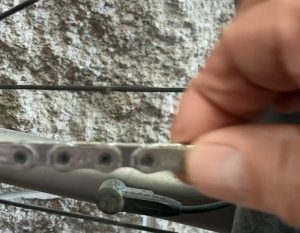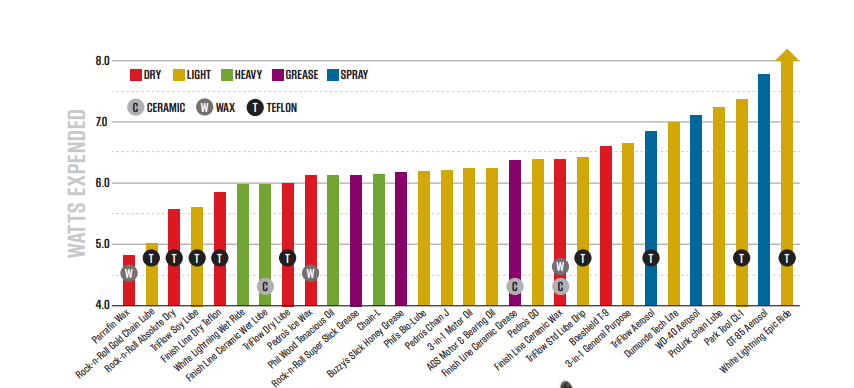By Lennard Zinn
When I was racing in the early 1980s, new chains were $4 retail. Now, a good-quality chain for an 11- or 12-speed drivetrain is at least tenfold (often even twenty- or thirty-fold) as expensive. And if you keep riding with a worn chain, you will have to also replace your cassette, which is far more costly than a chain—as much as $600.
Getting more life out of your chain will save you money, and it would be a nice bonus if you also could ride faster with the same energy expenditure or use less energy to ride the same speed. And wouldn’t it be great if your chain always stayed so clean that you could rub it and your fingers (or leg) would not get black? These are the benefits of immersive chain waxing, not to mention the incredible feeling of riding a completely silent chain that shifts super smoothly!

No grease!
Ten years ago, I arranged a lab test for VeloNews of chain friction with 30 different lubricants on thoroughly-cleaned, broken-in chains. Amazingly, the lowest friction was obtained by immersing the chain in molten canning wax (paraffin); we discovered that a racer looking for “marginal gains” could save around 4 Watts of energy. What we didn’t know about yet was durability (even though one might infer that a chain will last longer if its friction is reduced) or subsequent maintenance. Since then, Adam Kerin of Zero Friction Cycling has sussed that all out in an astronomical number of hours of drivetrain testing. And companies like Molten Speed Wax, Rex, and Silca have come up with even faster solid-wax formulations by adding slippery additives to paraffin wax.

VeloNews March 2013 issue: Effect of chain treatment on power
Chain wear is indicated by length gain. As the bushings, rollers, and pins get worn, the chain’s length increases. Since the spacing of teeth on the rear cogs and front chainrings is based on the precise half-inch spacing between chain pins, a chain that has elongated will not properly mesh with the teeth and will deform them. A new chain will skip on those teeth, and you will be replacing an entire cassette at considerable expense. Once a chain’s length has increased by 0.5%, continuing to use it will make the cassette unusable with a new chain.
Kerin has calculated the real cost of using different chain lubrication methods. This chart compares chain wear over thousands of kilometers of riding with over 40 different chain lubes; scroll down to see how much it would cost to ride 10,000km on a Dura-Ace drivetrain with each of those lubes. For instance, after 10,000km of riding on a chain immersed in either Molten Speed Wax or Silca Hot Melt Wax, the chain will only be 40% of the way toward that 0.5% length increase, whereas if Muc-Off Nano chain lube had been used, over seven chains and cassettes would have been consumed, at a cost of $3,745 AUD ($2,400 US). This is the test protocol.
Chain waxing requires significant work up front to not only clean the oil out of it but also to rinse out the solvents used to remove the oil; only then will the molten wax adhere to the metal. However, once the chain is cleaned and immersion-waxed, cleaning it is a thing of the past. Since it doesn’t pick up dirt, you simply wipe it with a clean rag and either apply a compatible wax-based drip lube on each roller, or you remove the chain and dip it in molten wax again. In dry conditions, expect to get 300-500 miles of smooth performance out of a dip-waxed chain.
Any drip lube used on a waxed chain must be compatible with the wax. Silca Super Secret, Effetto Mariposa Flower Power Wax, CeramicSpeed UFO, and Tru-Tension BananaSlip Tungsten will lubricate the chain almost as well as molten wax (and better than non-wax-based lubes) and will also not pick up dirt, since they are wax in a water emulsion. Allow to dry overnight; otherwise, rain can rinse them off if riding before they are set.
If you swish the chain again in molten wax, it gets cleaned; this doesn’t happen with re-lubing with drip lube. You can also clean a waxed chain in boiling water, blow-dry it, and immerse it again in molten wax. Buy extra master links, since the number of times you can reuse a quick link varies by manufacturer.
In mildly wet conditions, shorten the mileage before re-waxing: use one of the above drip lubes on the chain every 200 miles and re-dip the chain in molten wax every 1,000-1,500 miles. Only extreme conditions, like a 200-mile gravel race in pouring rain, will overwhelm the wax to the extent that you will have to apply oily chain lube during the event (wax drip lubes won’t stay on in those conditions). Afterward, the chain must be completely cleaned before immersing it in wax again.
The easiest way to get going with a waxed chain is to have somebody else clean and wax it, and we will do that for you at Zinn Cycles. We also sell pre-waxed chains, as well as the drip lubes compatible with a waxed chain. Once you have enjoyed the benefits of riding a chain that is always clean, silent, and lowest friction, you won’t want to go back! I know I never will.


